Itís quite an impressive and scary achievement, a
twelve-year-old boy, appearing in only his second film, gets the
starring role. His character is the main thrust of the movie, and on
screen almost the entirety of the film. It is based on a critically
acclaimed best-selling young adult novel. His role is significantly
bigger than the supporting roles by genuine movie stars like Liam Neeson,
Felicity Jones and Sigourney Weaver.
However, this is the place where young Scottish
actor Lewis MacDougall found himself a couple of years ago, when
director J.A. Bayona (The Orphanage) and the makers of the film
A Monster Calls chose him from a pool of over 1,000 boys who were
considered for the part. MacDougall only had one supporting film role
to his name Ė he played Peterís best friend in Joe Wrightís Pan Ė
so it was quite an ambitious choice.
MacDougall plays Conor, a morose Irish student who
is trying to come to terms with his life, in which he is regularly
bullied in school. His mother (Felicity Jones) is dying of breast
cancer, but no one will tell young Conor what is happening. His
grandmother (Sigourney Weaver) is a rather cold, distant woman, who is
dealing with her own pain and unable to comfort the boy.
One night, as he struggles to sleep, Lewis looks out
his window and sees a giant monster (played by Liam Neeson through
motion-capture CGI), formed from earth and a giant yew tree down the
valley. The monster starts coming on different nights to tell Conor
three stories, insisting after his three stories Conor must tell him a
story. He may be real or imagined, but it turns out that the monster
helps the boy to come to terms with his fears and what is happening in
his life.
It would be a difficult role for a veteran thespian
to play, but even more impressive for such a young man, early in his
career. He certainly impressed his famous co-star Liam Neeson, who
portrayed the monster of the title.
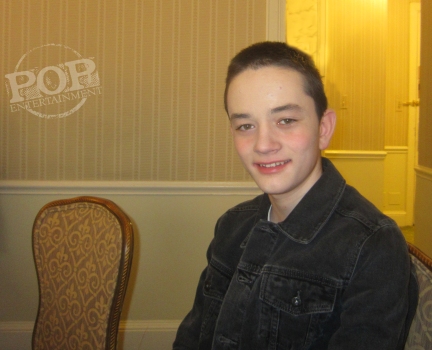 ď[MacDougall]
embarrasses Shakespeareís Hamlet with the range of stuff he has
there,Ē Neeson gushed about the young Scottish actor. ďReally
remarkableÖ. And it wasnít a performance. There was no acting.
Certainly not when I was with himÖ. Terrific what that kid doesÖ. He
makes it real. Thereís not an ounce of sentimentÖ. I canít praise that
boy enough.Ē
ď[MacDougall]
embarrasses Shakespeareís Hamlet with the range of stuff he has
there,Ē Neeson gushed about the young Scottish actor. ďReally
remarkableÖ. And it wasnít a performance. There was no acting.
Certainly not when I was with himÖ. Terrific what that kid doesÖ. He
makes it real. Thereís not an ounce of sentimentÖ. I canít praise that
boy enough.Ē
Now MacDougall is fourteen, and his film is entering
theaters with critical buzz. MacDougall also has two more films in the
can, Boundaries with Christopher Plummer and Vera Farmiga and
The Belly of the Whale with Pat Shortt and Michael Smiley.
A week or so before the release of A Monster
Calls, we were able to sit down with MacDougall in the famous
Waldorf-Astoria Hotel in New York for this exclusive one-on-one
interview.
You had mentioned you
were not familiar with the book until you were up for the role...
When I was asked to do the audition, I went and got
the book. I read it before I got the role.
What was it about the
story that intrigued you?
I think the fact that a lot of people can relate to
Conorís story. Whether they be a child or an adult, they were sad and
suffered a loss in their life, so they could really relate to that. I
also thought it could help people, especially those going through
grief.
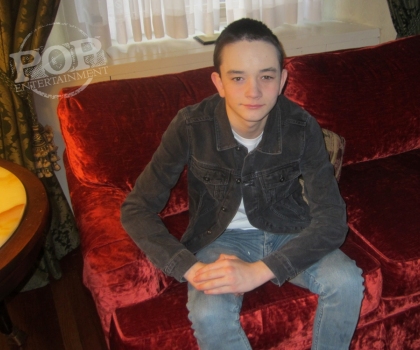 This
is your second film and your first lead. Youíre on screen pretty much
the whole time. What was it like to carry such a big project so early
in your career?
This
is your second film and your first lead. Youíre on screen pretty much
the whole time. What was it like to carry such a big project so early
in your career?
Yeah, as you said this is only my second film. When
I did the audition I was excited, but also a bit nervous, for the reason
that you said. It is really early in my career and Iím taking on such a
big role, which deals with a dark and emotional theme.
From what I hear, the
book is a bit darker than the movie.
I would say that the movie does the book good
justice in that way. If you talk to Patrick [Ness, the author of the
book and the screenplay adaptation], heíll tell you how when he first
was going to make the film, people suggested to maybe soften it. I
think thatís really something that we donít want. No, I donít think the
book is necessarily darker than the film. I think the film does the
book justice in that sense.
How much of the
character did you take from the book and how much came out while acting?
Obviously, this character has already been
established in the book. As a whole everybody wanted to do the book
justice. So, I did take a lot from the book. I read the book a couple
of times. I read it even after I filmed the movie. I read it again. I
definitely did take a lot of the character from the book, because there
is that whole character there, ready. I just needed to embody that.
[Director] J.A.
Bayona says you were one of 1,000 boys considered. He said he finally realized when it was down to
five people that you got it, you were playing the role with a barely
checked rage behind the sorrow. What was the auditioning process like?
I joined the whole process really late, actually.
It went on for a while before I was involved. Auditions, (chuckles)
they can be quite nerve-wracking. I guess I really just did what felt
right emotionally. I thought this is what Iím going to do. Iím going
to try to do this. I did what I felt was right.
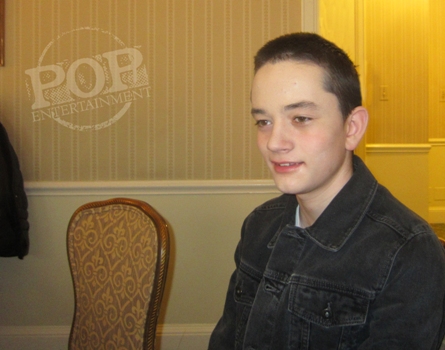 So
much of the movie is about the loss of a loved one and processing
grief. You said in the other room that your mother died about a year
before you made
A Monster Calls. Iím so sorry to hear that. Was that
something that made you connect with this character?
So
much of the movie is about the loss of a loved one and processing
grief. You said in the other room that your mother died about a year
before you made
A Monster Calls. Iím so sorry to hear that. Was that
something that made you connect with this character?
Yeah, I suppose. I mean, the thing of it is, itís
two completely different circumstances. I can understand the basic
feeling, but the circumstances are completely different. Conorís not
being told the truth at all. That wasnít the case for me. I think
thatís really what Conor is struggling with: not being told the truth of
what was going on with his mother. He has this thought in his mind
about it. He feels guilty because of that. Really itís that.
Something I talked about with Patrick and the director before we shot
was that Conor wanted to be punished, especially with the bullying
scenes. He wants to be punished. He feels like he deserves it, because
of what heís thinking. Really thatís not the case. That shouldnít be
the case at all. I suppose thatís really what the monster is trying to
teach him Ė among other things Ė that itís okay to think things like
that. Donít be hard on yourself because of it.
Did you ever have
dreams of monsters?
Well, when I was younger, I guess like any child I
had stuff like the monster underneath my bed. I really think this
monster that Conor encounters is different to what a lot of people
[had]. The term monster is really something that doesnít necessarily
have to be scary and horrible. For Conor itís this spirit that came to
help him encounter and face his biggest fear.
One thing I loved in
the picture was, it was subtle, but in the family pictures all over
there was a picture of Liam Neeson as your grandfather. That sort of
made me think, oh, okay, that suggests another entirely different idea
about what the monster was to Conor. Do you think the monster is almost
a mixture of his beliefs, and his mother, and grandfather?
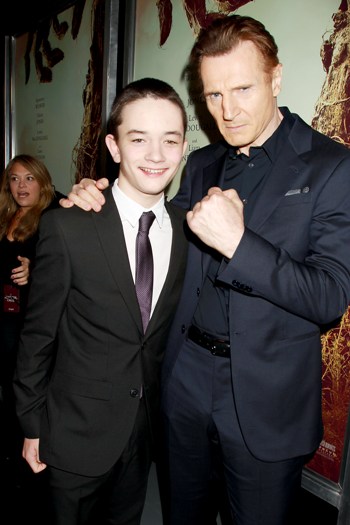 That
thing with Liam being [the grandfather] ..., obviously as you see in the
movie, Conorís grandfather has died before Conor ever had a chance to
meet him. So, yes, Liam Neeson is that character in the photos. You
know, I havenít really read too much into that. People, I guess, can
read a lot into it and say that the monster represents his grandfather
and stuff like that, but Iím not really sure if that is the case. I
suppose really the monster represents to me not so much Conorís
grandfather, but more of a grandfatherly kind of figure. Somebody who
can really teach Conor about life. This monster sprung from a yew tree,
and yew trees can last for hundreds of years. He represents someone who
has had a lot of experience about life and tries to pass it on to Conor.
That
thing with Liam being [the grandfather] ..., obviously as you see in the
movie, Conorís grandfather has died before Conor ever had a chance to
meet him. So, yes, Liam Neeson is that character in the photos. You
know, I havenít really read too much into that. People, I guess, can
read a lot into it and say that the monster represents his grandfather
and stuff like that, but Iím not really sure if that is the case. I
suppose really the monster represents to me not so much Conorís
grandfather, but more of a grandfatherly kind of figure. Somebody who
can really teach Conor about life. This monster sprung from a yew tree,
and yew trees can last for hundreds of years. He represents someone who
has had a lot of experience about life and tries to pass it on to Conor.
Patrick said in the
book there was a character that unfortunately had to be cut from the
movie, a girl who was Conorís best friend. In school, Conor had a
miserable experience, no friends and getting pushed around. The movie
takes a hard look at bullying, which is such an important topic in
todayís world. Why do you think bullying is such a concern these days?
Itís not that people are getting bullied more today
than they were in the past, itís just that people are actually starting
to combat it. Itís an important thing to make people aware that this is
going on. Make people aware and have them coming to help. Like I said,
the thing that really attracted me to the film in the first place is how
it can help people who are not just children, but also adults who have
suffered bereavement or are being bullied.
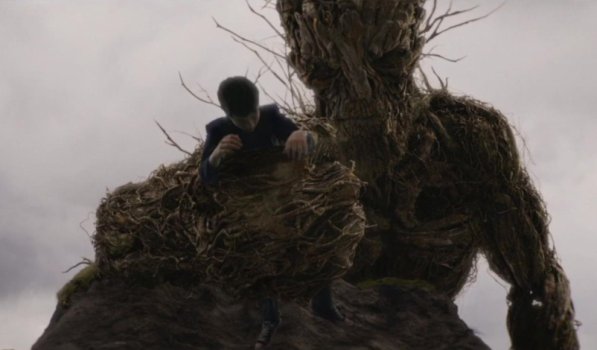 Liam
was saying this was his first time working with motion capture. He said
at first it was weird in the onesie with ping pong balls all over him
and you across the room so he couldnít even see you. Was it strange for
you acting in that way?
Liam
was saying this was his first time working with motion capture. He said
at first it was weird in the onesie with ping pong balls all over him
and you across the room so he couldnít even see you. Was it strange for
you acting in that way?
The thing is, it was weird, because obviously I
havenít done motion capture. Thatís something I shared with him,
because he hadnít either. Yeah, it was a strange experience, but it was
also a good one, because it gave me the opportunity to rehearse the
scenes with a real person, and take that on to set.
Why do you think only
Conor and apparently your mother could see the monster?
Are you talking about the ending, the book and the
artwork that you may think are from the mother? Well, I think that
could be interpreted differently by a lot of people. I guess, if you
look at it... Iíve heard people say this and it made me think this
myself: the mother talks about how she lost her father. The
grandfather, obviously Iíve talked about him already. I donít know
whether maybe she saw this monster as well, to try and help her with
that and now Conor is seeing it in the situation with her. I sort of
maybe interpreted that she got help from the monster when she was
suffering with the loss of her father.
Felicity is such a
great actress, but sheís playing a woman who is fading away. How hard
was it to see Felicity made up in some of the scenes where her illness
was progressing?
The great thing the film does, it really shows the
whole process of Felicityís character, the mother, getting sicker and
sicker. They really show that well: with the prosthetics and stuff [it
shows] she didnít have long. The relationship between Conor and his
mother is really a non-traditional relationship. Itís like a brother
and sister relationship, or even like they are both best friends.
Thatís probably because the mother had Conor at a relatively young age.
She Ė along with the father Ė were probably too young really to be
parents. Thatís something thatís probably one of the reasons why the
father is no longer there. With Felicity, to replicate the two
characters being so close, we had bonding sessions. The day before we
had to shoot, we went to the zoo together. Just me and her. We had a
day there. We also went to a theme park and went out for dinner a
couple of times, really just to get comfortable with each other and
replicate the relationship the mother and son had.
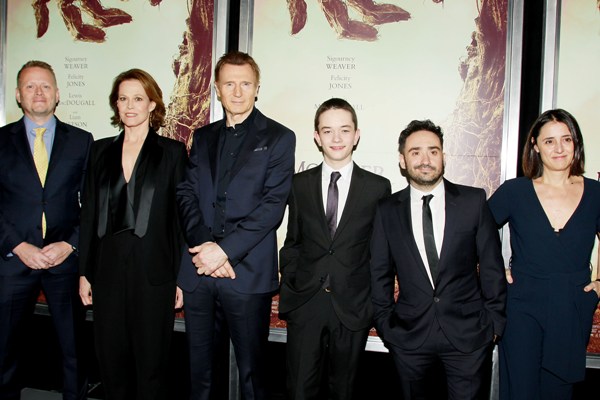 The
character of your grandmother, played by Sigourney Weaver, is a little
distant and cold for much of the film, but as it goes on the two of you
do grow together. What was she like to work with?
The
character of your grandmother, played by Sigourney Weaver, is a little
distant and cold for much of the film, but as it goes on the two of you
do grow together. What was she like to work with?
Just like the relationships with the actors who
played the bullies in the film, I had a really good relationship with
Sigourney off-screen. Thatís important to keep in mind. A lot of
people maybe concentrate on what Conorís going through, and that is very
important. But youíve also got to look at what is happening to the
grandmother, because she is losing her only daughter. That must be an
unimaginable thing to go through. Working with her was really, really a
privilege. Just down to the way she treated everyone with respect, and
as her equal. Thatís something I really admired about her, and I also
try to do myself.
Obviously Sigourney
and Liam have done so many movies. How familiar were you with their
careers when you started working with them?
Yeah, I was definitely familiar with them.
Were you a little
star struck to be working with these people youíd been seeing in big
movies for so long?
At first, yeah, I probably was a bit star struck,
but they were really such terrific and great people and I am honored
that I got the opportunity to work with both of them.
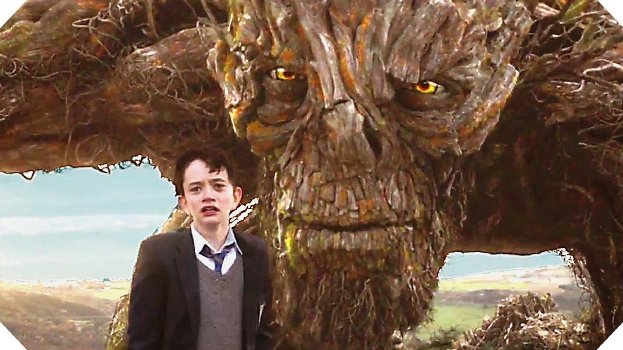 Had
you seen either of J.A. Bayonaís films before signing on?
Had
you seen either of J.A. Bayonaís films before signing on?
Iíd seen The Impossible. He does such great
work Ė and you see it in The Orphanage as well Ė with children.
Heís really good at working with children, bringing the best out in
them, I suppose. The work he did with Tom Holland in The Impossible
[was amazing]. Tom Holland is somebody I really admire. I
was fortunate enough to get to meet him. So, yeah, I did look at J.A.ís
previous films. You can definitely see similarities, in terms of the
relationships. Theyíre all very family-oriented.
You have two other
movies coming out. What can you tell us about them?
Earlier this year I did a film called Boundaries
with Vera Farmiga and Christopher Plummer, directed by Shana Feste.
That tells the story of me and my grandfather, who is played by
Christopher Plummer. Heís kicked out of the nursing home and we go on a
road trip down the west coast of America. When he was younger, he was a
criminal and he ends up getting me involved in that. I just finished a
film in Ireland called The Belly of the Whale. That tells the
story of my character and [an actor] called Pat Shortt, his character
Ronald. We are two misfits that are brought together and end up having
to rob an arcade.
CLICK HERE TO SEE WHAT LIAM NEESON HAD TO SAY
ABOUT A MONSTER CALLS!
Email us Let us know what you think.